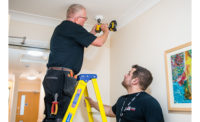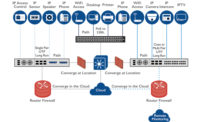Countries around the world have committed to reducing pollution and their environmental footprints. In March 2015, the U.S. submitted a target to the United Nations Framework Convention on Climate Change (UNFCCC) to reduce the country’s net greenhouse gas emissions by an ambitious 26 percent to 28 percent below 2005 levels by 2025. China committed to limit its greenhouse gas emissions with a commitment to peak emissions around 2030 and to increase its share of non-fossil energy consumption to around 20 percent by 2030. The European Union put forward a target to cut emissions 40 percent by 2030.
Many businesses across the country, including security companies, are willingly doing their part to develop more sustainable, environmentally friendly business practices to reduce their carbon footprint and save energy and resources as well. But, the question is, can integrators be both successful and environmentally conscious? The answer is, yes they can. In fact, integrators say they have seen countless positive benefits in many areas of their businesses with some of the “green” steps or practices they’ve implemented over the years, including increased employee engagement and operational improvements.
When Vivint of Provo, Utah, built its first facility more than seven years ago, the company took an interest in its consumption. After all, says Tom Few, vice president of business development at the company, the word Vivint is derived from vive meaning live, and int. meaning intelligent or live intelligently. “We are a progressive company with a dynamic future and we place a substantial amount of effort on staying green and staying contemporary.”
For starters, the company offers preferred parking at its headquarters facility for efficient, low emission vehicles. “It promotes our initiatives and gives those employees that are contributing to our green efforts prime spots,” he explains. In addition, Vivint has a composting and recycling campaign in its cafeteria. “Handling the compost used to be a part of the chores of our CEO’s son,” Few says, adding that, as a company, Vivint internally promotes its green initiatives and does all it can to ensure its employees are in line with that same mentality.
A Green Culture
To be successful with green practices, according to Few and other integrators, a company needs to promote a sustainable culture within the entire organization. “We started recycling about five years ago, but it was a half-hearted effort,” recalls Joe Liguori, managing partner at Access Control Technologies Inc. (ACT), Clifton, N.J. “About a year later, we recognized that we needed to support our efforts better and make sure every employee understood. Slowly, the culture began to change.”
Since that first effort, ACT has implemented more sustainable business practices, lowering the company’s energy bills by about 40 percent and making employees happier and more engaged.
“We knew parts of our building were inefficient and our monthly bills for consumption were going up exponentially,” Liguori says. ACT brought in a third-party company to evaluate and the first step it took was to change ACT’s 460-some lightbulbs to LED and install automatic lighting that would shut off when no one was present. The company also changed out its old and inefficient heating and cooling machines to computerized, high-efficiency versions that constantly adjust airflow and temperature. Liguori says the company had thought about some of these changes long ago, but it wasn’t until they found out they would qualify for a state of New Jersey reimbursement plan for many of these upgrades that it made the decision easy.
“Our building is cleaner, brighter, and it makes our employees’ work environment better and also engages them,” he says. “It was an educational process for all of us and it has brought us closer together as a company.”
Another company that has realized an additional level of positive engagement from employees by encouraging green initiatives is Time Warner Cable (TWC), New York City. A handful of years ago, the company decided to go full speed ahead with its corporate responsibility program, of which green initiatives is a spoke of that policy, says Dave Flessas, TWC’s senior vice president of network operations and executive lead of TWC’s Go Green initiative.
“Our initiatives go all the way to our CEO Robert D. Marcus and most senior levels of the company, so our changes have been really organic and the growth in participation we have seen has been pleasantly surprising,” Flessas says.
The company has implemented a number of green initiatives with significant results. TWC received accreditation from the National Association of Fleet Administrators (NAFA) as a Sustainable Fleet for its progress made toward reducing total emissions and the negative environmental impact made by extraneous carbon fuel usage. After making extensive changes, including adding more than 400 diesel Ford Transit vans and 200 Transit Connect vans to its fleet in recent years, the Transit vans achieved an estimated 47 percent improvement in fuel economy, according to the company.
TWC also achieved several LEED certifications for locations throughout the U.S. and has installed solar photovoltaic systems at locations in Hawaii and at its National Data Center East in Charlotte, N.C. “We have also recently gone into a partnership with residential solar providers so that our employees will have the opportunity to install solar panels on their homes at a discount,” Flessas adds.
One of TWC’s biggest initiatives is carbon intensity reduction. In 2012, TWC set a goal to reduce its carbon intensity by 15 percent and surpassed that goal with a 38 percent reduction. The company announced a new goal to further reduce carbon intensity by 30 percent before the end of 2016. According to Flessas, the company will continue to invest in fuel efficient vehicles, aim to reduce cooling power consumption, pursue LEED elements in all new buildings and seek additional renewable energy opportunities.
Perhaps the most impactful initiative TWC has made — not in terms of lofty goals or carbon intensity reduction, but in terms of reaching the most people and creating a company culture of environmental awareness — is its Go Green teams. A few years ago, TWC initiated local employee volunteer teams, encouraging them to come up with green events and ideas that could be implemented in their communities.
“We have had great success establishing Green Teams in 19 states,” Flessas reports. “The number of the teams and participation in the teams has grown greatly over the last couple of years as we’ve continued. As employee participation in the Green Teams has increased, so have the ideas that the teams have come up with. In addition to conducting green fairs for educating the community and local employees about environmental issues and holding community recycling events, TWC’s Green Teams have looked at everything from upgrading lighting in their individual buildings to brainstorming better and less wasteful packaging, Flessas says.
“The bottom line is, it’s good business,” he adds. “Almost all the green activities we have engaged in to date have been not only good for the environment, but really very effective operationally as well.”
Positive Benefits; Positive Impact
WM Security Services Inc., headquartered in Houston, has seen many positive benefits from its green initiatives as well. “If you work here, being environmentally conscious is really a part of our culture from orientation through your daily work life, and it filters down through us to our community and to our family and friends,” says David W. Lee, manager, security operations center.
The security firm has made several mindful changes to its business, including upgrading monitors to high-efficiency LED models, automatic lighting timers to detect office vacancies, non-disposable glassware and silverware in the breakrooms, defaulting to double-sided printing, and a company-wide email close that reminds recipients that “Recycling is a good thing. Please recycle any printed emails.”
But the company’s largest green initiative, embraced by its subsidiaries, is its recycling and electronics recycling or e-cycling efforts, according to Lee. “We have an in-house technical lab where we test and use different security equipment. As those items have to be put to rest, we make sure we do so in an appropriate manner,” he explains.
For everyday recycling, WM Security Services collects bottles and plastics in a single stream initiative, meaning it doesn’t ask employees to separate recyclables into individual bins such as paper, glass bottles and plastics. “We separate that out at our recycling facilities and that alone allows us to collect 30 percent more recyclables than we would with a multi-stream concept,” Lee says.
Last year during Earth Day, WM Security Services, working with other Waste Management subsidiaries, launched a program it called the “tiny toter trade off,” says Kimberly Levicky, business analyst at the company. Standard office trash bins were replaced with smaller bins, minus the plastic liners, to save plastic and show its employees about being more environmentally conscious.
Going Green Creates Efficiencies
One of the morals of these green stories is that integrators don’t have to have large budgets to implement green practices. Small and mid-size organizations can make many of the same changes of larger companies and have a meaningful impact. “We are a small business and I am not willing to spend a lot of money, but I do think everyone can make some choices to save the environment and also save some money,” says Thomas Marino, president of Advanced Technologies, Baton Rouge, La. “At our office, I want everything as efficient as possible and that means LED lighting, recycling our stuff and printing on the backside of papers,” Marino notes.
While a positive environmental impact is definitely an end result of sustainable initiatives, Marino and other integrators agree that it is not always the primary driver behind the change. Many years ago, Provident Security Corp., Vancouver, B.C., Canada, implemented several green initiatives, including bicycles for guard response and a paperless office. Implementing the bicycles was an operational decision first, says Mike Jagger, president of Provident. The company offers a five-minute guaranteed response time and, for some areas of the city, it is faster, more convenient and most efficient to ride a bike rather than get behind the wheel of a vehicle. “We use them where it makes the most sense,” Jagger says.
In addition, more than a decade ago, Provident began moving to a paperless office, addressing the sales process, contracts and invoicing. “At this point, about 98 percent of the business is paper-free,” Jagger says. “These things are good for the environment, but the real savings is in sanity. It’s just so much simpler to see where something starts and finishes and all steps in between with a digital system. There is more transparency, more sharing and an ability to have more people involved. And just from a stress standpoint, the transparency brings so much value to the table before having saved a dime in costs.”
Transparency and consistency were two of the reasons integration firm Cantara of Costa Mesa, Calif., implemented a cloud-based file system about three years ago, according to Jason Voorhees, president of the company. “Before, we were constantly printing out blueprints for technicians and using tons of paper. It’s not only wasteful but it takes a lot more time to get those printed. Drawings can be in the wrong place at the wrong time and get lost or left at a site,” he says. “Moving to a cloud-based system, there was a lot of improvement with consistency right away and far less paper wasted.”
Another sustainable practice that Cantara implemented at its 4,000 square foot office space is energy management, and the benefits are two-fold, according to Voorhees. It helps the company save on energy bills and create a more sustainable office environment, but also gives the company an opportunity to use and be able to speak about some of the systems it sells to customers. “Our system is tied into the security, lighting and HVAC,” adds Adam Purath, director of engineering at Cantara. “It closes the shades, sets back the HVAC and turns off all the lights when we leave, for example.”
But while the ideas behind Cantara’s push for paperless and energy management integration may be more than purely environmental, one push at the company that is purely green is its electronics recycling initiative for which it spends a fair amount of time, warehouse space and money to maintain.
“For us, we are the type of company that waste is a guilt factor on a lot of people’s minds,” Voorhees says. “We don’t want to throw stuff away. It’s part of who we are.” This way of thinking led Cantara to initiate an electronics recycling program that recycles its own electronics as well as a large amount of electronics from customer homes. “We put a massive amount of electronics into people’s homes and our clients have the type of income where they can renovate and completely replace their entire systems in a matter of years,” Voorhees says. “So it’s very common for us to go into a home and within a couple of days have van loads full of old electronics. Years ago, that would end up in a dumpster and we thought, ‘wow, what an impact this would make.’” The company sets aside a portion of its warehouse to store used electronics for recycling pick up that sometimes equals a few bin loads each month.
“It’s a completely environmental effort that we are very happy about,” Voorhees says. “It may cost us money to store everything for a month and take up a good chunk of our space, but it’s the right thing to do.”
Creating Consciousness
While integrators implement green practices for a number of different reasons, one of the resounding themes among companies that have taken such steps is a level of consciousness — consciousness that improvements can be made.
“You can make small changes, go after low hanging fruit, see cost savings and make an impact,” says Ken Erdmann, president of Erdmann Electric Inc., Springville, Utah. “Then, you think about less obvious, more hidden ways to make an impact.” The company recycles everything it can, views trade magazines in digital formats instead of print, makes an effort to buy things in recyclable containers, and reuses everything it can, including bubble wrap, paper and boxes.
“It’s a matter of thinking,” Erdmann says. “If a manufacturer sends me stuff with packing peanuts, I will call them up and ask them not to use that for me next time.” In addition, the company sells and recycles metals from its jobs, and even allows employees to use the small amount of money received to buy donuts and coffee. “It’s an incentive to encourage them to recycle,” he says.
Erdmann Electric also focuses on energy management in its office with occupancy sensors for automatic heating/cooling and lighting adjustments, Nest thermostats and LED lighting. “We are selling these technologies and teaching our clients about energy management, and if we live with those technologies it makes them easier to sell,” Erdmann explains.
For companies that haven’t begun to go green, Erdmann encourages them to be conscious, think and evaluate all areas of their business. Some green practices may be implemented to streamline processes, reduce headaches or save money, but the main intention doesn’t matter in the sense that the results will still be the same: helping make the business more sustainable and positively impacting the environment.
Tax Benefits From Going Green
Making green changes to a building or company may qualify for a tax incentive or other benefit. It is important to do the research and find a third-party evaluator that may be able to make recommendations for you and your business.
- While many Energy Star programs of the U.S. Environmental Protection Agency and U.S. Department of Energy expired in 2011, there are still some credits available through 2016 for commercial buildings. See: http://1.usa.gov/1PS6Myo
- Electronics recycling may be able to be claimed as a charitable contribution when partnering with a nonprofit, according to TurboTax. See: http://intuit.me/1K0IRNO
- Other loan programs, funding opportunities, tax incentives and rebates also exist. Good places to start:
- The Database of State Incentives for Renewables and Efficiency: www.dsireusa.org
-
The U.S. Small Business Administration: www.sba.gov/content/environmental-grants-loans
More Online
For more on green initiatives in the industry, visit SDM’s website where you’ll find the following articles:
“A Snapshot of Sustainability in the Security Industry: 2014”










